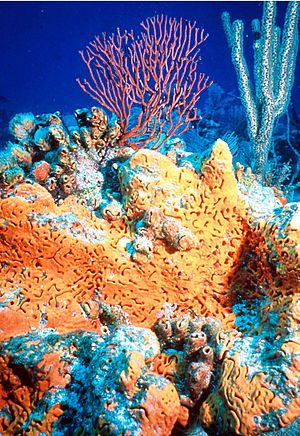Unikont facts for kids
Quick facts for kids Unikonts |
|
|---|---|
 |
|
| An orange elephant ear sponge. | |
| Scientific classification |
|
| Domain: | Eukaryota |
| (unranked): | Unikonta Cavalier-Smith, 2002 |
| Subgroups | |
|
|
| Synonyms | |
|
|
Unikonts are a major group of eukaryotes. Eukaryotes are living things whose cells have a nucleus. Scientists use a system called biological classification to sort all living things into groups. Unikonts are one of the five main "superkingdoms" in this system.
This group was named by a scientist named Thomas Cavalier-Smith in 2002.
What are Unikonts?
Scientists believe Unikonts form a "clade". A clade is a group of living things that all share a common ancestor. This means they are all related.
Unikonts include eukaryotic cells that have one of these features:
- They have a single flagellum. A flagellum is a whip-like tail that helps a cell move.
- They are amoebae with no flagella. Amoebae are tiny, single-celled organisms that change shape as they move.
The Unikont group includes two main parts:
- Opisthokonts: This group contains animals, fungi, and other related life forms.
- Amoebozoa: This group includes many types of amoebae.
How are Unikonts Different?
Other well-known eukaryotic groups are often called bikonts. Bikonts include Archaeplastida (like plants), Excavata, Rhizaria, and Chromalveolata. These groups often have two flagella, though there are many exceptions.
Unikonts have a special feature that bikonts do not. They have three genes that are joined together. These genes create enzymes that help make important building blocks for cells called pyrimidine nucleotides.
This joining of three genes is very rare. It suggests that Opisthokonts and Amoebozoa share a common ancestor. This special gene fusion helps scientists understand how these different life forms are connected.

